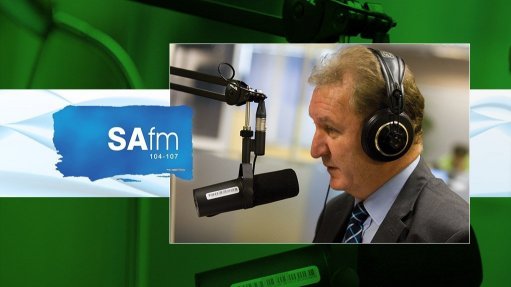Americans, Australians partner to build out, scale up global green hydrogen ecosystem

Plug CEO Andy Marsh's green hydrogen presentation covered by Mining Weekly's Martin Creamer. Video: Darlene Creamer.
JOHANNESBURG (miningweekly.com) – Building out and scaling up a global green hydrogen ecosystem collaboratively is at the heart of an American-Australian business partnership announced this week, amid 30-plus countries already having hydrogen strategies in place that focus on the deployment of green hydrogen to achieve net-zero climate-mitigation goals.
Plug of the US, headed by Andy Marsh, and Fortescue Energy of Australia, headed by Mark Hutchinson, outlined to 3 000 virtual attendees their common mission of spreading green hydrogen across the world, while at the same time fighting climate change by slashing carbon emissions, cleaning up industry, electrifying vehicles, powering commercial and residential buildings, and generating a substantial number of sustainable jobs. (Also watch attached Creamer Media video.)
“This is a big market opportunity. It’s really a focus of Plug every day to make hydrogen an ubiquitous fuel, and that’s why I get so excited when we partner with companies like Fortescue. We have a similar vision and know we have to make hydrogen easy,” Marsh told the company's fifth annual symposium, which was covered by Mining Weekly.
Great news for South Africa is that the 550 MW electrolyser that Plug will supply to Fortescue’s Gibson Island Project in Brisbane is a proton exchange membrane (PEM) electrolyser. This is because PEM electrolysers are platinum-based and South Africa hosts the world’s largest resource of platinum group metals.
Fortescue’s final investment decision on that project is expected to be taken by the end of December. Once operational, the plant will produce 385 000 t/y of green ammonia from the green hydrogen produced onsite through the hydrogen electrolysis facility.
In addition, Plug and Fortescue have started the initial diligence process for Fortescue to take up to a 40% equity stake in Plug’s Texas hydrogen plant and for Plug to take up to a 25% equity stake in Fortescue’s proposed Phoenix hydrogen plant.
Meanwhile, across North America and Europe, Plug has deployed more than 60 000 fuel cells and 180-plus fuelling stations and plans to build and operate a green hydrogen highway.
Fuel cells, which go hand-in-glove with platinum-based green hydrogen electrolysers, contain platinum catalysts that convert the green hydrogen into clean electricity for mobile and stationary use.
PEM electrolysers were first developed during the 1950s for the space programme and have transitioned to the mainstream as the case for green hydrogen has strengthened, driven by the need to find solutions to combat climate change. The improving business case for green hydrogen is based on growing renewable generation capacity, falling renewable electricity costs, and PEM’s innovative advance.
“Gibson Island’s one of our first projects. Eventually we want to work on how do you replace the LNG market globally. That’s like the Holy Grail in our view.
“Just think about the last 12 months, how governments around the world have really accelerated this industry. We’re very much at the starting gate of this industry, we’ve got a long way to go, but there’s plenty to do for everybody,” said Hutchinson.
Bloomberg estimates that 20% of world energy will come from hydrogen by 2050. By 2030, Europe will be using 10-million tons of domestically produced hydrogen a year and will also be importing another 10-million tons of hydrogen. Europe has made it clear that 42% of this hydrogen must be green hydrogen. The US will be generating 10-million tons of its own hydrogen.
“When we do a back-of-the-envelope calculation, just for our electrolyser business, just for Europe, just for the United States, it’s a $40-billion opportunity between now and 2030, just for one small segment of our business.
“So, yes, hydrogen’s going to be big, and we’ve been building it out. We’ve been building infrastructure for the last 15 years, and what I’ve learnt over those 15 years is that when you’re in the energy business, regulations matter. The Inflation Reduction Act of the US comes out important, the Renewable Energy Directive that came out of Europe on Monday, which is 42% green hydrogen, that’s really important.
“Helping to guide our legislators and our executive branch on how they implement these regulations and how to help build a big economy is something Plug’s deeply involved in and which is really important for our future.
“We have had thoughtful discussions about how to implement the law so that it grows investment in the United States, makes our economy green and creates jobs like you see in this building today when you walk around,” said Marsh.
Plug has a joint venture (JV) in South Korea with SK Group to build an electrolyser and fuel cell gigafactory. The hydrogen network in South Korea will have over 14 fueling stations by the end of 2024, and 300 to 500 buses on the road in the next 18 months.
In the UK, Johnson Matthey, which has long-standing South African links, is working with PEM electrolyser developer Hystar, to enable further scale-up and automation for Hystar’s planned multi-gigawatt production line.
In the US, Norwegian company Nel Hydrogen has announced plans to build an automated gigawatt PEM and alkaline electrolyser manufacturing facility in Michigan.
Plug delivers its green hydrogen solutions directly to its customers and through JV partners into multiple environments, including materials handling, e-mobility, power generation and industrial applications.
Green hydrogen, produced by the electrolysis of water, using renewable electricity, is described by Plug as a miracle molecule that can bring energy sovereignty to countries with sun, wind or hydropower.
In bringing together every hydrogen touchpoint, Plug is engaged across a broad spectrum to make the green hydrogen economy a happy place, with adequate infrastructure. The company’s end-to-end green hydrogen offering includes production, storage and delivery to energy generation, to help customers meet their business goals and decarbonise the economy.
While Plug was conducting its fifth yearly symposium, the European company Lhyfe, a world pioneer in the production of green and renewable hydrogen for transport and industrial applications, was turning the first sod for the construction of a hydrogen production plant in the German city of Schwäbisch Gmünd. This plant will be the first to supply hydrogen directly to an industrial park. It is also the first in a network of many plants that will be operated by Lhyfe, which is setting out to deliver green hydrogen in bulk in Germany and France by 2025.
ZERO-CARBON FUEL
Green hydrogen is a zero-carbon fuel produced by splitting water into hydrogen and oxygen using an electrolyser that employs renewable electricity.
When used, it produces primarily water and is being increasingly seen as the holistic way for humankind to decarbonise the planet in a job-generative manner.
There is a global drive to reduce the production cost of green hydrogen from between $5/kg and $3/kg currently to below $1/kg.
In South Africa, steel producer ArcelorMittal South Africa is moving ahead with a study into the production of green hydrogen directly reduced iron (gHDRI) at its mothballed Saldanha Steel Works, in the Western Cape. The JSE-listed group has signed a memorandum of understanding with an as yet unnamed “developer of transformational energy solutions” to advance the production of gHDRI at the plant.
South Africa could emerge as a low-cost producer of green hydrogen, owing to its natural resource endowments of sun, wind and land, which together with electrolyser costs, are the main drivers of cost competitiveness.
Should green hydrogen be produced competitively on the West Coast, possibly using desalinated water, there is potential for the Saldanha Works to emerge as a large source of green hydrogen demand, consuming up to 104 000 t/y in the production of gHDRI.
LONG-TERM STORAGE CAPABILITY
The growth of green hydrogen in the world’s energy system is significant because of its long-term energy storage capabilities, which could help to decarbonise transport, heating and industrial processes.
The US’s National Clean Hydrogen Strategy has a stated ambition of enabling multi-gigawatt-scale electrolyser manufacturing capacity.
In parallel, the US’s Infrastructure Investment and Jobs Act (IIJA), enacted on November 15, 2021, has a variety of initiatives to stimulate new markets for clean hydrogen, including $1-billion of funding for a clean hydrogen electrolysis programme, aimed at improving the efficiency and cost-effectiveness of electrolysis technologies by supporting the entire innovation chain – from research, development and demonstration to commercialisation and deployment – to enable $2/kg clean hydrogen from electrolysis by 2026.
IIJA also provides $8-billion of funding for the provision of Regional Clean Hydrogen Hubs, two of which were announced for New York this week.
Recent developments highlight how both manufacturing capacity and deployment are ramping up, with Plug manufacturing 122 MW of its 1 MW PEM electrolyser stacks at its factory in the US, achieving an all-time high for the industry.
WORLD PLATINUM INVESTMENT COUNCIL
In its latest release, the World Platinum Investment Council (WPIC) says electrolyser capacity is ramping up as both production and deployment expand globally, in response to green hydrogen demand growth.
The WPIC calculates that $300-billion in hydrogen investments are earmarked through to 2030, while the International Energy Agency (IEA) reports strong electrolyser manufacturing growth.
The WPIC estimates that demand for hydrogen could potentially rise seven times higher by 2050, with two-thirds of hydrogen production coming from electrolysis, while the IEA reports that there could be a four-fold increase in global electrolysis installed capacity compared with 2022.
Additionally, the WPIC expects one-million fuel cell electric vehicles (FCEVs) to be on China’s roads by 2035 and that one in eight newly registered commercial vehicles worldwide will be powered by hydrogen fuel cells by 2030.
The broad-based commercial adoption of FCEVs could add more than three-million ounces to yearly platinum demand in 10 years’ time.
Comments
Press Office
Announcements
What's On
Subscribe to improve your user experience...
Option 1 (equivalent of R125 a month):
Receive a weekly copy of Creamer Media's Engineering News & Mining Weekly magazine
(print copy for those in South Africa and e-magazine for those outside of South Africa)
Receive daily email newsletters
Access to full search results
Access archive of magazine back copies
Access to Projects in Progress
Access to ONE Research Report of your choice in PDF format
Option 2 (equivalent of R375 a month):
All benefits from Option 1
PLUS
Access to Creamer Media's Research Channel Africa for ALL Research Reports, in PDF format, on various industrial and mining sectors
including Electricity; Water; Energy Transition; Hydrogen; Roads, Rail and Ports; Coal; Gold; Platinum; Battery Metals; etc.
Already a subscriber?
Forgotten your password?
Receive weekly copy of Creamer Media's Engineering News & Mining Weekly magazine (print copy for those in South Africa and e-magazine for those outside of South Africa)
➕
Recieve daily email newsletters
➕
Access to full search results
➕
Access archive of magazine back copies
➕
Access to Projects in Progress
➕
Access to ONE Research Report of your choice in PDF format
RESEARCH CHANNEL AFRICA
R4500 (equivalent of R375 a month)
SUBSCRIBEAll benefits from Option 1
➕
Access to Creamer Media's Research Channel Africa for ALL Research Reports on various industrial and mining sectors, in PDF format, including on:
Electricity
➕
Water
➕
Energy Transition
➕
Hydrogen
➕
Roads, Rail and Ports
➕
Coal
➕
Gold
➕
Platinum
➕
Battery Metals
➕
etc.
Receive all benefits from Option 1 or Option 2 delivered to numerous people at your company
➕
Multiple User names and Passwords for simultaneous log-ins
➕
Intranet integration access to all in your organisation


















